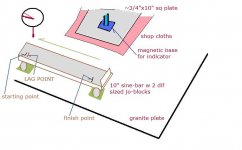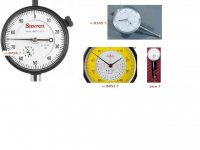A Method for Testing - [Proving] Indicators
Hi Antique Forum
Following is a method that I have arrived at for determining the accuracy of indicators.
This is a development from the way I was first shown oh
not so many years ago, in 1957.
I was then apprenticed to a master journeyman tool and die maker who was also a lead-man in an ultra-precision tool and die shop. He is one of my heroes, that you only come across once in a lifetime. He was a tall gentleman, in his 60s, extremely dignified, soft-spoken, and very kindly to me. I feel guilty now, for being so naive back then; thinking that this was not so uncommon; and now realizing that he was a one and only. One of the projects I was supposed to do to complete my apprentice-ship, was to make a 5" sine-bar. But rather quickly, one of the older tool makers gave me his as a token of friendship, followed soon after by another, and finally one more that didn't want to be left out. So, I had 3 ! - 5" sine-bars in my tool-box. After thinking this over, my master tool and die maker left me off the hook, thinking diplomacy and shop politics - they might think that I (or him) was dissatisfied with the quality of their sine-bars etc.
Very early on, he wanted to teach me his system for testing - proving - indicators. We have 3 concerns.
1.
LAG. This is the actual amount of physical movement on the indicator taking place
before the needle nudges in movement. Typically, on the quite a few that I tested through the years; it was ~.00015, with some poor cases
greater than .001. A .00015 lag means you are already off .0003 on an OD. I did have one moderately priced Japanese model that had
zero lag and was my favorite for a number of years. One time I forgot when setting up a semi-CNC drill, and left my indicator in the spindle set for ~2000 rpm. When I started the mach, it slung my indicator across the shop like a bullet and ripped the back off. I took it to the dealer asking how much a new back cost. He fixed it with a replacement, and
new lens at no charge. When I tested that indicator again, it
still had no lag !! Lag needs to be factored in for high-accuracy.
2.
MEASUREMENT. How accurate is the amount indicated on the instrument compared with the
actual amount?
3.
REPEATABILITY. How accurate will your indicator
consistently repeat?
The principle for testing is quite simple, a very slightly angled bar is slid under the indicator. The method that my hero taught me, was to use the granite-plate, with the indicator magnetic base fastened to an ~10" sq plate, and protection for the granite by several layers of shop towels. Then, a 10" sine-bar with 2 slightly different sized jo-blocks are slid under the indicator. There is
much math involved with this system; and I wont trouble us with details. I confess, I was always un-easy with shop towels being part of the equation, and couldn't rest until I removed them from the process. A basis sketch is included below.. btw, he would have went back to ~1915 starting his apprenticeship,,, so younger men, through me you are going back a century into ancient history.
View attachment 118454
In many of the shops out there, especially those doing big rough work, which was my love in my 40s - do not use granite plates. I was forced to improvise. Following is an illustration.
View attachment 118455
The system I finally came up with, was using 2 parallels; most of the time on my bench-plate, or at times, even on the machine itself. As you can see in the sketch below, it is a greatly simplified process. One inch movement on the top parallel equals ~.0005 movement on the indicator.
View attachment 118456
The last sketch is examples of indicator readings, which for many years now, I've needed about a 30X magnifier w good light. So how about it? what are your systems?
View attachment 118457


















